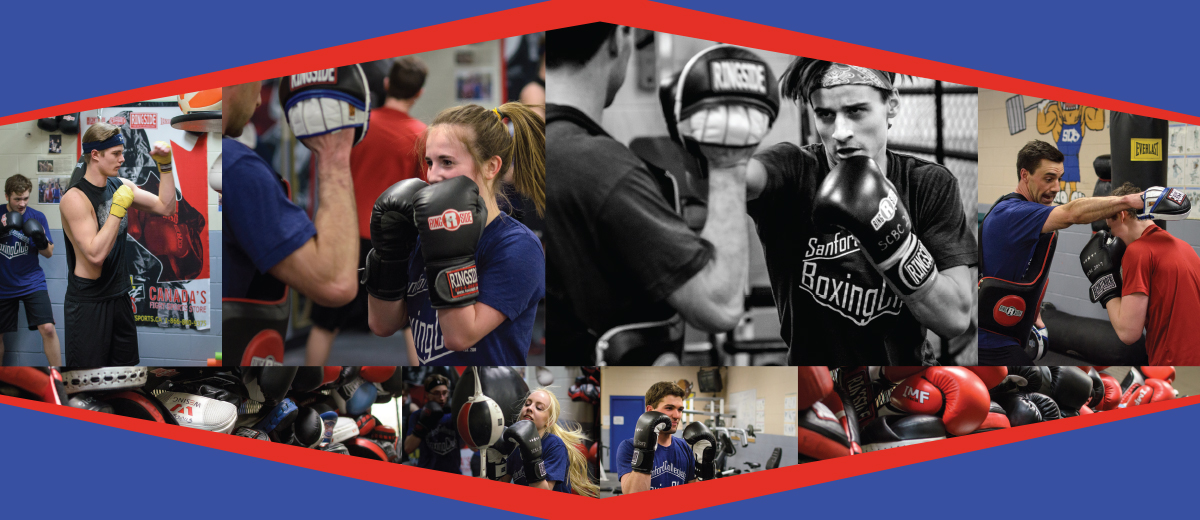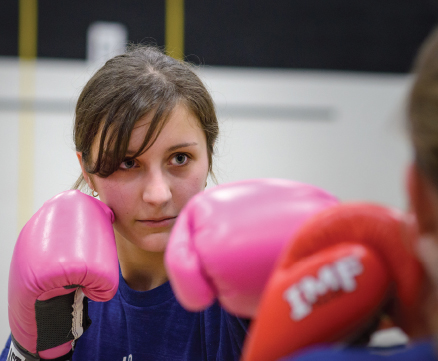
Photos & Story By Matea Tuhtar
At Sanford Collegiate, punching a teacher is not only allowed, it’s encouraged. And once you throw your punch he’ll teach you how to do it better, and harder, next time.
Sanford Collegiate is home to the province’s only extra-curricular boxing club. The club got started in 2011 by science teacher Mike Zurba whose own background in boxing spurred him to introduce his students to the sport. The club started off with just him and 30 kids and it has now grown to four teachers and 62 students – an impressive number considering the school’s population is 271.
“It’s really become a rather large footprint on the culture of Sanford Collegiate.”
Zurba started boxing while in high school and trained at Pan Am Boxing in Winnipeg’s Exchange District, mostly to get himself into shape for hockey.
“I quickly found out it was a better workout than hockey ever was. I like the competition of it. You find out a lot about yourself when you’re fighting and when you push yourself as far as you can possibly go. And that is what I thought the sport could offer the kids here. We put them through quite a lot in their workout and when they come out of it they have a little bit more confidence because it’s hard not to feel a little tougher after you do a workout like this.”
The club has converted a former storage space in the school’s gymnasium into a full-fledged boxing gym, and participating students pay $40 for the program which goes towards maintaining and buying equipment. A lot of the equipment has been sourced second hand to make it affordable. They also have their own t-shirts and hoodies, awards at the athletic banquet and a special training session with head coach Harry Black at Pan Am Boxing.
The program starts in the second semester of school. The teachers hold a three-week rookie camp for Grade 9 students which introduces them to the sport and eases them into it through less-strenuous workouts. Grades 10-12 go through a six-week training camp where, three days a week, they learn key aspects of the sport including boxing intro, endurance, power, accuracy, fight strategy and final round technique.
Zurba has designed a training plan that teaches the students techniques such as hand wrapping, punch combos, generating power, foot work and fight philosophy. The one hour workout is non-stop and intense. The students not only do boxing drills but build their endurance through squats, ab work and cardio.
“We try to get them in shape first and then we work on technique,” says Zurba. “In a fight, you have to be able to continue for a long time so you need to be really fit.” The teachers also go over nutrition and hydration and how to take care of your body to prepare it for the strain.

Mike Zurba has designed a training plan that teaches the students techniques such as hand wrapping, punch combos, generating power, foot work and fight philosophy. The one hour workout is non-stop and intense. The students not only do boxing drills but build their endurance through squats, ab work and cardio.
Though the workout is exhausting, the actual boxing fights are not dangerous.
“We’re not sparring, it’s all very controlled. After six weeks it’s kind of like a game of tag with body contact from waist to shoulders, and no head contact at all. But just because these kids are not going to get into fights doesn’t mean we can’t train them like fighters. We do everything except for the sparring rounds like an actual fighter would do.”
And the punches haven’t spilled over into the school hallways.
“We’ve had one fight here in five years. I think it’s actually less since the boxing club has started. Maybe it’s because anyone who knows how to throw punches are all friends now,” laughs Zurba. “It takes the fight out of kids when they realize how hard fighting actually is.
“I talk a lot about the mental side of it and pushing their limits. We work out to failure, until your muscles can’t handle it anymore. They learn something about themselves. And every time they hit that wall, the next workout they’ll be pushed a little further and it’ll be a little tougher.”
There used to be a drop off at the beginning of the program where students stopped when they realized how hard it is, but Zurba says that’s not the case anymore.
“Everyone knows what they’re in for and you don’t want to be the one who quits.”
That includes the four teachers who run the club for 15 weeks straight.
“We get into shape, relieve stress, generate student connections and experience an overall happier mental health at work and at home. You don’t want the kids to be in better shape than you so you push yourself!”
“We’re constantly developing the program and changing things up – it keeps us on our toes,” says Industrial Arts teacher Brendan McManus who caught the bug and now boxes at Pan Am with Zurba and coaches fighters there as well.
“The kids kind of walk around with a badge of pride, like ‘Yeah I’m in a boxing club, no big deal!’
McManus says he sees a lot of Sanford kids training at Pan Am in their spare time where it’s free for kids under 18– “I see at least 20 regularly!”
The students that get into the program don’t have to be very athletic or co-ordinated, and often don’t participate in any other sports. They just need to push themselves and not give up.
“We’re not sparring, it’s all very controlled. After six weeks it’s kind of like a game of tag with body contact from waist to shoulders, and no head contact at all. But just because these kids are not going to get into fights doesn’t mean we can’t train them like fighters. We do everything except for the sparring rounds like an actual fighter would do.”
McManus recalls a particularly shy student who ended up addicted to the sport. “We had one girl who went down two pant sizes and she said I think four words to me the entire semester – a really quiet kid. But she never missed a workout and after we finished we kept working out for an extra two weeks because she wanted to keep going.”
The boxing club has always had a 50/50 split with guys and girls, something that just happened naturally according to Zurba.
“The sport is all mental, most of these girls that we have are tougher than the guys. It takes a tough girl to jump into this.”
Grade 12 student Bailey Thompson is in her third year of boxing and says she joined because she wanted a good workout.
“I thought it would be a good way to get in shape and try out a new sport. My brother had done it when he was in high school as well and he liked it.” Thompson says it was a bit intimidating at first and she had to build endurance. “Kicking the boys’ butts is fun – maybe the best part!”
This year the club began its assistant trainer program where a seasoned Grade 12 student can become an assistant instructor for the Grade 9 students, showing up to their workouts and leading their own workout near the end. Building their leaderships skills is just another way the club has benefitted the students.
“I see the kids’ confidence grow over the six weeks,” says Zurba. “And I find my teaching is way easier when I can connect with this many kids outside the classroom. There’s no behavior problems. When they know you put the time in they show appreciation.
“You can’t help but build a bond with the people you’re working out with. For any teachers with an athletic background – start a club! For the amount of destressing that you get for your mental health I would recommend it to anyone.”
The Sanford boxing club teachers plan to hold a SAGE info session during MTS PD Day this fall to share the program with other teachers, and Zurba encourages other teachers to contact him if they would like any info: mzurba@rrvsd.ca
— This story was originally printed in the April/May 2017 issue of The Manitoba Teacher Magazine
